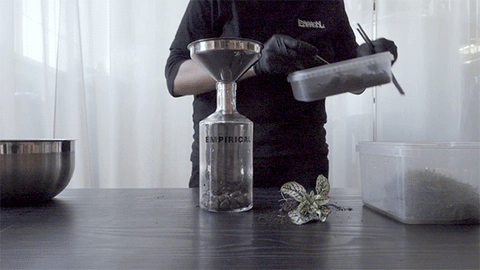Let us paint a picture. It’s Saturday evening, you just swallowed the last drop of your favorite Empirical tipple. No plans on the horizon for your Sunday but chilling in the warmth of your home. And in the corner of your eye, there is that beautiful bottle staring at you, begging not to be thrown away.
Well, here’s one of the many ways you can reuse your bottle and bring life back to it on your rainy Sunday. Or any other day.
Niki has many talents, one of them having an incredible green thumb. She created beautiful herbariums for our Tasting Room and thought you’d like to make one yourself.
It will look great on your windowsill and your friends' too.
And if you don’t have an empty bottle lying around, why not get a full one first? We promise the empty process to be delectable!
Alright, here’s how it’s done.
What you need:
- 1x empty bottle
- Long tweezers
- Gravel (small stones)
- Activated charcoal
- Soil
- Moss
- Plant of choice
- Plant mister
How to make it:
Step 1

Rinse your bottle. Clean your gravel and let them cool down.
Step 2

Place the gravel in your bottle to create drainage and sprinkle your activated charcoal over them
Step 3

Add your soil as your thicker layer, leaving a large enough hole in the middle for your plants
Step 4

Place your plants with long tweezers, starting from the largest to the smallest, and lightly pack the soil. Be careful not to overcrowd the plants, leaving them enough space to grow.
Step 5

Pack moss over the soil layer.
Step 6

Clean your bottle and leave it open for a couple of days for the moisture to evaporate. Use a plant mister to avoid overwatering in the following days.
Your terrarium is now done. But what’s next? We rounded up some helpful tricks to keep your precious terrarium in tip-top shape.
What plants though?
First things first, key factors for a healthy terrarium include light requirements and preferences in moisture level and temperature.
Mosses and ferns are especially thriving in a terrarium, and trendy plants like Peperomias, Pilea and Baby Tears can be easier to grow behind glass than on a dry windowsill. Exotic epiphytes and the low-growing nerve plant also do the trick.
If you want to bring color to your terrarium, small orchids, mini-African violets, and other flowering exotics work wonders.

Open or closed?
Closed terrarium care should be easy. During the first week, it is essential to check the terrarium daily.
Foggy glass indicates that there is too much water in the system. This is common in new setups, but it can happen any time you overwater. The solution is simply to open the terrarium to reduce the moisture.
Once ventilation has cleared the glass, you can reclose the system. But keep an eye on it. Repeat the process until you see condensed droplets at the top but the terrarium’s glass remains clear.
Sad-looking plants?
Watch the leaves for signs of wilting or yellowing. Wilting in dry soil means that the plant needs a drink, and in this case, we mean water. But, if they are drooping in wet soil, it can be a sign of problems with root rot.
When the plants reach the desired height, pinch back any new shoots. This will make them grow in width. Remove any dead leaves to prevent disease.
And importantly, stay alert for mold
Planting Tips
Rinse your plants carefully before putting them in the terrarium. You don’t want to introduce bugs, mold, or foreign chemicals.
Make sure your soil and the gravel are sterile to avoid bringing pests and mold spores into a closed system.
Allow growing room.
Trim the roots to keep a plant smaller. Don’t cut the large tap roots, just the thread roots that grow from them.
Ok, but how do terrariums actually work?
The coolest part of having a terrarium is seeing how nature creates and sustains a living microcosm. Understanding how a closed system works helps you maintain it properly.
The soil within the terrarium supports healthy microbial processes that nourish living plants. Moisture from evaporation and plant transpiration recirculate as condensed “rain” droplets that keep the soil moist.
Photosynthesis powers a dynamic cycle that keeps the air healthy. The terrarium’s plants use light to produce oxygen which is consumed at night; carbon dioxide is consumed during the day through photosynthesis and produced through the dark hours by plant respiration.
Nature. Mind Blowing.